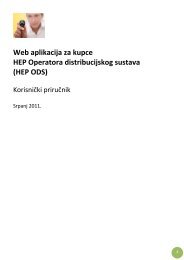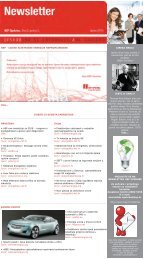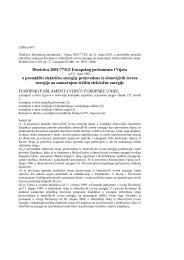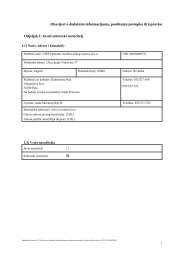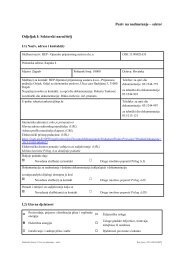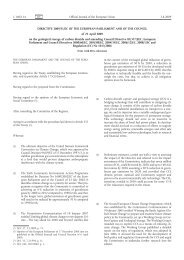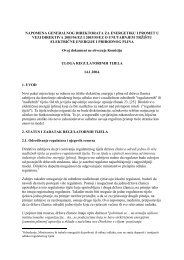Untitled - HEP Grupa
Untitled - HEP Grupa
Untitled - HEP Grupa
- No tags were found...
You also want an ePaper? Increase the reach of your titles
YUMPU automatically turns print PDFs into web optimized ePapers that Google loves.
Viπeagentski sustav se razlikuje od onog u kojemje samo jedan agent u postojanju veÊeg broja agenataod kojih svaki utjeËe na ciljeve i djelovanjasvih drugih (promatrano iz perspektive jednogagenta ostali su njegovo okruæenje). Takoappleer postojimoguÊnost direktne interakcije (komunikacije)izmeappleu dva ili viπe agenata. Ta interakcijaagenata moæe biti promatrana kao dio okruæenja ilipotpuno odvojeno od okruæenja agenata.Iz perspektive jednog agenta stvari se dramatiËnokompliciraju ulaskom u viπeagentski sustav s obziromna situaciju kada je potpuno sam u svomokruæenju. Naime ovdje svi ostali agenti svojimdjelovanjima utjeËu na promjenu okruæenja. Naslici 7 nalazi se prikaz dva agenta koji se nalaze uistom okruæenju i pri Ëemu svaki ima svoje ciljeve(meappleusobno razliËite), postupke djelovanja i znanjaiz odreappleene domene. Na istoj slici prikazanaje i moguÊnost direktne komunikacije izmeappleu ovadva agenta.A multi-agent system differs from a system in whichthere is only one agent due to the presence largenumber of agents, each of which influences the goalsand actions of all the others (from the perspective ofone agent the other constitute its environment). Thereis also the possibility of direct interaction (communication)among two or more agents. This agent interactioncan be studied as a part of the environment orcompletely separated from the agent environment.From the perspective of an agent, matters becomedramatically more complicated by entering a multiagentsystem due to the situation when it is completelyalone in its environment. All the other agentshere influence change in the environment with theiractions. In Figure 7, two agents are presented thatare in the same environment and each has its owngoals (mutually different), action procedure andknowledge of a certain domain. In the same figure,possibilities are presented for direct communicationbetween these two agents.Okruženje / EnvironmentSlika 7Dva agenta u istomokruæenjuFigure 7Two agents in the sameenvironmentAgent /AgentAgent /Agent• ciljevi / goals• postupci / actions• znanja iz domene/ domainknowledge• ciljevi / goals• postupci / actions• znanja iz domene/ domainknowledgeSasvim opÊenito, moguÊe je postojanje po voljivelikog broja agenata koji se meappleusobno viπeili manje razlikuju i mogu, ali i ne moraju, imatimoguÊnost komunikacije s ostalim agentima.»est je sluËaj da se agenti, koji saËinjavaju istiviπeagentski sustav, bitno razlikuju jedni od drugih.TipiËan primjer su programski agenti (engl.softbot) koji se razlikuju u realizaciji od strane razliËitihdizajnera. OpÊenito, razlike mogu biti bilohardverske bilo softverske. Ovakvi agenti nazivajuse heterogenima za razliku od homogenih koji sudizajnirani na identiËan naËin.U viπeagentskom sustavu prisustvo veÊeg brojaagenata uzrokuje veÊu dinamiËnost okoline, a timei sloæenost promatranog problema.Quite generally, it is possible for a large number ofagents to exist, as desired, who mutually more orless differ and can, but not necessarily, have thepossibility of communicating with the other agents.It is frequently the case that agents comprising thesame multi-agent system differ from each othersignificantly. Typical examples are program agents(software robots or softbots), which differ accordingto the designers. Generally, differences can existin hardware or software. Such agents are calledheterogeneous, in contrast to homogeneous agentsthat are designed in the identical manner.In a multi-agent system, the presence of a largenumber of agents makes the environment more dynamicand thereby increases the complexity of theproblem studied.659Rajšl,I., Krajcar, S., Krpan, K., Primjena višeagentskih sustava u …, Energija, god. 56(2007), br. 6., str. 642-675Rajšl, I., Krajcar, S., Krpan, K., Application of Multi-Agent System in …, Energija, vol. 56(2007), No. 6, pp. 642-675



